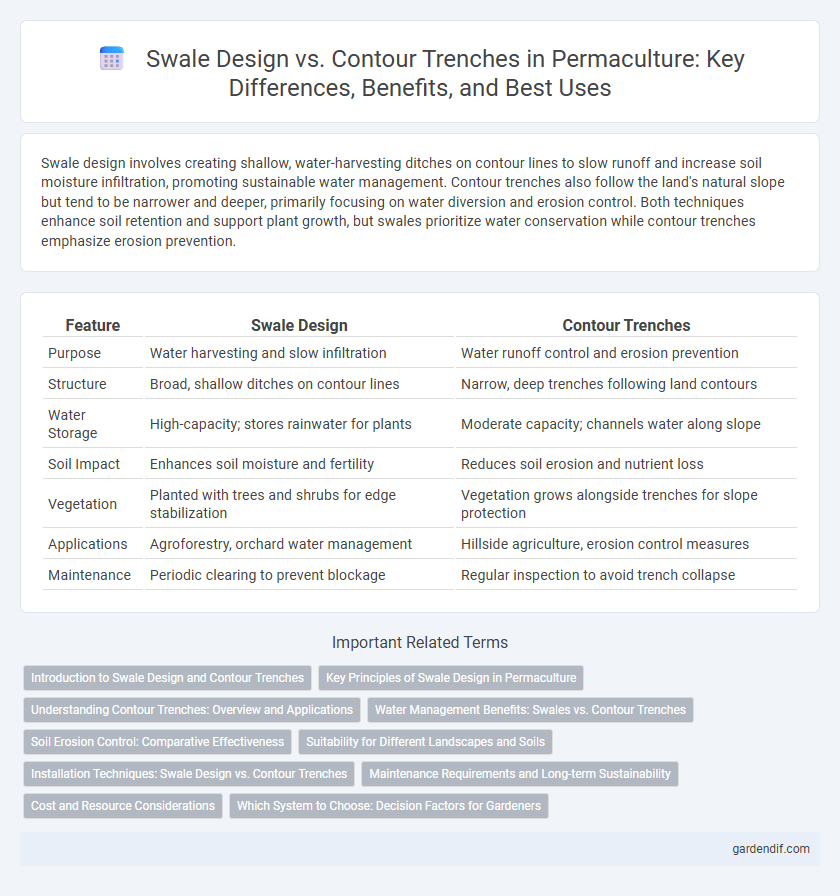
Swale Design vs Contour Trenches Illustration
Swale design involves creating shallow, water-harvesting ditches on contour lines to slow runoff and increase soil moisture infiltration, promoting sustainable water management. Contour trenches also follow the land's natural slope but tend to be narrower and deeper, primarily focusing on water diversion and erosion control. Both techniques enhance soil retention and support plant growth, but swales prioritize water conservation while contour trenches emphasize erosion prevention.
Table of Comparison
| Feature | Swale Design | Contour Trenches |
|---|---|---|
| Purpose | Water harvesting and slow infiltration | Water runoff control and erosion prevention |
| Structure | Broad, shallow ditches on contour lines | Narrow, deep trenches following land contours |
| Water Storage | High-capacity; stores rainwater for plants | Moderate capacity; channels water along slope |
| Soil Impact | Enhances soil moisture and fertility | Reduces soil erosion and nutrient loss |
| Vegetation | Planted with trees and shrubs for edge stabilization | Vegetation grows alongside trenches for slope protection |
| Applications | Agroforestry, orchard water management | Hillside agriculture, erosion control measures |
| Maintenance | Periodic clearing to prevent blockage | Regular inspection to avoid trench collapse |
Introduction to Swale Design and Contour Trenches
Swale design involves creating shallow, broad channels along the land's contour to capture and infiltrate rainwater, promoting soil hydration and reducing erosion. Contour trenches, in contrast, are narrow, deeper ditches placed along contour lines to intercept surface runoff and increase groundwater recharge. Both techniques enhance water management in permaculture, but swales emphasize water retention and soil building, whereas contour trenches focus on directing and slowing water flow.
Key Principles of Swale Design in Permaculture
Swale design in permaculture emphasizes water catchment by creating level ditches along natural contour lines, enabling maximum infiltration and reducing soil erosion. Key principles include precise topographic assessment to ensure swales follow the contour, slow water movement to enhance groundwater recharge, and integration with vegetation for stabilized soil and improved microclimates. Unlike contour trenches, swales are typically broader and hold water temporarily, serving as a foundational element for sustainable land management and carbon sequestration.
Understanding Contour Trenches: Overview and Applications
Contour trenches are shallow, strategically placed ditches dug along land contours to capture and infiltrate rainwater, reducing soil erosion and increasing groundwater recharge. Unlike swales, contour trenches are typically smaller, more closely spaced, and are often used in arid or degraded landscapes to restore moisture and support vegetation growth. Their applications include reforestation projects, agroforestry systems, and soil conservation efforts where water retention and erosion control are critical for ecosystem restoration.
Water Management Benefits: Swales vs. Contour Trenches
Swale design and contour trenches both enhance water management by capturing and infiltrating rainfall to reduce erosion and improve soil moisture. Swales are typically broader and designed on contour lines, promoting slow water absorption and facilitating groundwater recharge in permaculture landscapes. Contour trenches, narrower and often deeper, focus on directing runoff while preventing surface water velocity, making them effective in steeper terrains for erosion control and sediment capture.
Soil Erosion Control: Comparative Effectiveness
Swale design excels in soil erosion control by capturing and slowly infiltrating water along contour lines, reducing runoff and promoting groundwater recharge. Contour trenches effectively intercept surface water flow but may require more maintenance due to sediment accumulation and potential overflow. The gradual water absorption in swales generally provides superior erosion mitigation compared to the more immediate but less controlled runoff management of contour trenches.
Suitability for Different Landscapes and Soils
Swale design excels in gently sloping landscapes with deep, well-draining soils, effectively capturing and infiltrating water to support diverse plantings and reduce erosion. Contour trenches are better suited for steeper terrains or compacted soils where rapid water runoff risks soil loss, as they slow water flow and enhance infiltration along contour lines. Selecting between swales and contour trenches depends on topography, soil texture, and land management goals to optimize water retention and landscape resilience.
Installation Techniques: Swale Design vs. Contour Trenches
Swale design involves digging earthworks along contour lines to capture and infiltrate water, using berms and ditches to slow runoff and promote soil moisture retention. Contour trenches, typically deeper and narrower, are excavated along similar contour lines but focus on directing water flow for erosion control and irrigation, often incorporating rock or mulch lining for stability. Installation of swales requires careful grading to maintain level contours, while contour trenches demand precise alignment and reinforcement to manage higher water volumes and prevent trench collapse.
Maintenance Requirements and Long-term Sustainability
Swale design typically requires less maintenance than contour trenches due to its ability to effectively capture and slowly release water, promoting deep soil infiltration and reducing erosion over time. Contour trenches may demand more frequent clearing and reinforcement to prevent sediment buildup and structural damage, which can compromise their efficiency. Swales offer enhanced long-term sustainability by supporting diverse plant growth and improving soil health, leading to resilient landscapes with minimal ongoing intervention.
Cost and Resource Considerations
Swale design typically requires less excavation and materials compared to contour trenches, making it more cost-effective for water retention and soil conservation in permaculture systems. Contour trenches often demand more labor-intensive digging and structural reinforcement, increasing resource use and overall expenses. Choosing between swales and contour trenches depends on site-specific factors, budget constraints, and the scale of land management goals.
Which System to Choose: Decision Factors for Gardeners
Swale design and contour trenches both serve to manage water efficiently in permaculture, but choosing between them depends on factors like soil type, slope gradient, and garden size. Swales are ideal for capturing and slowly infiltrating water in gentle slopes with deep-rooted plants, while contour trenches excel in steeper terrains with heavier soils that require rapid drainage. Gardeners must assess site-specific hydrology and vegetation needs to optimize water retention and erosion control effectively.
Swale Design vs Contour Trenches Infographic

 gardendif.com
gardendif.com